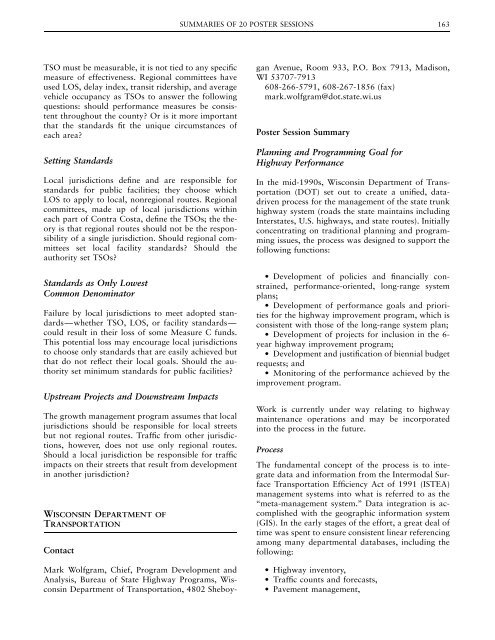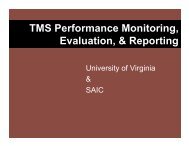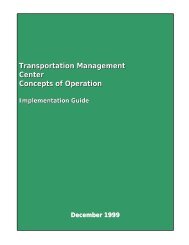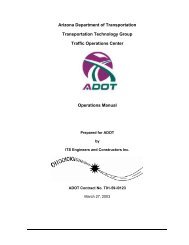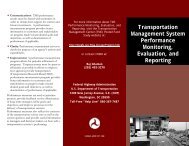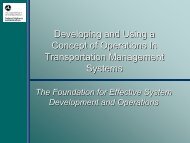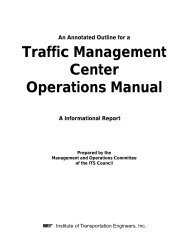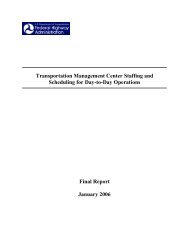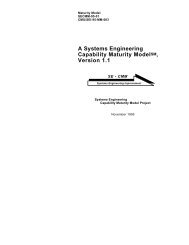Conference Proceedings 26 - Transportation Research Board
Conference Proceedings 26 - Transportation Research Board
Conference Proceedings 26 - Transportation Research Board
- No tags were found...
You also want an ePaper? Increase the reach of your titles
YUMPU automatically turns print PDFs into web optimized ePapers that Google loves.
SUMMARIES OF 20 POSTER SESSIONS 163TSO must be measurable, it is not tied to any specificmeasure of effectiveness. Regional committees haveused LOS, delay index, transit ridership, and averagevehicle occupancy as TSOs to answer the followingquestions: should performance measures be consistentthroughout the county? Or is it more importantthat the standards fit the unique circumstances ofeach area?Setting StandardsLocal jurisdictions define and are responsible forstandards for public facilities; they choose whichLOS to apply to local, nonregional routes. Regionalcommittees, made up of local jurisdictions withineach part of Contra Costa, define the TSOs; the theoryis that regional routes should not be the responsibilityof a single jurisdiction. Should regional committeesset local facility standards? Should theauthority set TSOs?Standards as Only LowestCommon DenominatorFailure by local jurisdictions to meet adopted standards—whetherTSO, LOS, or facility standards—could result in their loss of some Measure C funds.This potential loss may encourage local jurisdictionsto choose only standards that are easily achieved butthat do not reflect their local goals. Should the authorityset minimum standards for public facilities?Upstream Projects and Downstream ImpactsThe growth management program assumes that localjurisdictions should be responsible for local streetsbut not regional routes. Traffic from other jurisdictions,however, does not use only regional routes.Should a local jurisdiction be responsible for trafficimpacts on their streets that result from developmentin another jurisdiction?WISCONSIN DEPARTMENT OFTRANSPORTATIONContactMark Wolfgram, Chief, Program Development andAnalysis, Bureau of State Highway Programs, WisconsinDepartment of <strong>Transportation</strong>, 4802 SheboyganAvenue, Room 933, P.O. Box 7913, Madison,WI 53707-7913608-<strong>26</strong>6-5791, 608-<strong>26</strong>7-1856 (fax)mark.wolfgram@dot.state.wi.usPoster Session SummaryPlanning and Programming Goal forHighway PerformanceIn the mid-1990s, Wisconsin Department of <strong>Transportation</strong>(DOT) set out to create a unified, datadrivenprocess for the management of the state trunkhighway system (roads the state maintains includingInterstates, U.S. highways, and state routes). Initiallyconcentrating on traditional planning and programmingissues, the process was designed to support thefollowing functions:• Development of policies and financially constrained,performance-oriented, long-range systemplans;• Development of performance goals and prioritiesfor the highway improvement program, which isconsistent with those of the long-range system plan;• Development of projects for inclusion in the 6-year highway improvement program;• Development and justification of biennial budgetrequests; and• Monitoring of the performance achieved by theimprovement program.Work is currently under way relating to highwaymaintenance operations and may be incorporatedinto the process in the future.ProcessThe fundamental concept of the process is to integratedata and information from the Intermodal Surface<strong>Transportation</strong> Efficiency Act of 1991 (ISTEA)management systems into what is referred to as the‘‘meta-management system.’’ Data integration is accomplishedwith the geographic information system(GIS). In the early stages of the effort, a great deal oftime was spent to ensure consistent linear referencingamong many departmental databases, including thefollowing:• Highway inventory,• Traffic counts and forecasts,• Pavement management,


